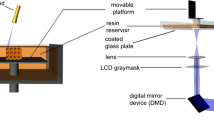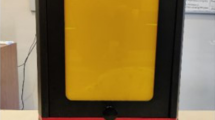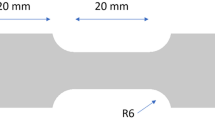Projection stereolithography (SLA) is a layer-by-layer 3D printing technique used to create complex structures and intricate geometries with high accuracy and surface finish. The final mechanical properties of any SLA printed parts are highly dependent on the process parameters and post-cure process. Proper post-curing helps cross-linking the unreacted double bond remaining after the printing and thereby enhance the mechanical strength. In this study, the impact of process parameters such as infill density, exposure time, and layer height on the tensile strength of Phrozen Beige low-irritation resin was investigated first. Maximum tensile strength of 25.792 MPa was attained at 100% infill volume of a layer thickness of 30 μm for an exposure time of 8 s. The effect of post-curing time and temperature on the ultimate tensile strength was evaluated. Phrozen Beige resin demonstrated an increase of 33.56% after 1 hour of post-curing at 25°C. Phrozen Aqua-Gray 4K resin exhibited an improvement of 44.57% after 2 h of post-curing at 25°C. Maximum tensile strength and faster achievement of completely cured state occurred at a higher post-curing temperature at the heat deflection temperature due to the acceleration of cross-linking of uncured photopolymers.






Similar content being viewed by others
References
A. Mitchell, U. Lafont, M. Holynska, and C. Semprimoschnig, “Additive manufacturing – A review of 4D printing and future applications,” Addit. Manuf., 24, 606–626 (2018), https://doi.org/10.1016/j.addma.2018.10.038.
J. Huang, Q. Qin, and J. Wang, “A review of stereolithography: Processes and systems,” Processes, 8, No. 9, 1138 (2020), https://doi.org/10.3390/PR8091138.
Z. Liu, Y. Wang, B. Wu, et al., “A critical review of fused deposition modeling 3D printing technology in manufacturing polylactic acid parts,” Int. J. Adv. Manuf. Technol., 102, No. 9, 2877–2889 (2019), https://doi.org/10.1007/s00170-019-03332-x.
C. E. Corcione, “Development and characterization of novel photopolymerizable formulations for stereolithography,” J. Polym. Eng., 34, No. 1, 85–93 (2014), https://doi.org/10.1515/POLYENG-2013-0224.
J. Wang, S. Das, R. Rai, and C. Zhou, “Data-driven simulation for fast prediction of pull-up process in bottom-up stereo-lithography,” Comput. Aided Des., 99, 29–42 (2018), https://doi.org/10.1016/j.cad.2018.02.002.
C. Zhou, H. Ye, and F. Zhang, “A novel low-cost stereolithography process based on vector scanning and mask projection for high-accuracy, high-speed, high-throughput, and large-area fabrication,” J. Comput. Inf. Sci. Eng., 15, No. 1, 1–8 (2015), https://doi.org/10.1115/1.4028848.
J. Z. Manapat, Q. Chen, P. Ye, and R. C. Advincula, “3D printing of polymer nanocomposites via stereolithography,” Macromol. Mater. Eng., 302, No. 9, 1–13 (2017), https://doi.org/10.1002/mame.201600553.
A. Della Bona, V. Cantelli, V. T. Britto, et al., “3D printing restorative materials using a stereolithographic technique: a systematic review,” Dent. Mater., 37, No. 2, 336–350 (2021), https://doi.org/10.1016/j.dental.2020.11.030.
N. A. Chartrain, C. B. Williams, and A. R. Whittington, “A review on fabricating tissue scaffolds using vat photopolymerization,” Acta Biomater., 74, 90–111 (2018), https://doi.org/10.1016/j.actbio.2018.05.010.
H. Y. Jeong, E. Lee, S. C. An, et al., “3D and 4D printing for optics and metaphotonics,” Nanophotonics, 9, No. 5, 1139–1160 (2020), https://doi.org/10.1515/nanoph-2019-0483.
M. Mukhtarkhanov, A. Perveen, and D. Talamona, “Application of stereolithography based 3D printing technology in investment casting,” Micromachines, 11, No. 10, 946 (2020), https://doi.org/10.3390/mi11100946.
F. P. W. Melchels, J. Feijen, and D. W. Grijpma, “A review on stereolithography and its applications in biomedical engineering,” Biomaterials, 31, No. 24, 6121–6130 (2010), https://doi.org/10.1016/j.biomaterials.2010.04.050.
Yu. M. Volkov, E. V. Vorob’ev, A. V. Drozdov, et al., “Effect of a temperature on the mechanical characteristics of ULTEM 9085 thermoplastic produced by additive technology”, Strength Mater., 52, No. 3, 414–418 (2020), https://doi.org/10.1007/s11223-020-00192-9.
Q. Ge, Z. Li, Z. Wang, et al., “Projection micro stereolithography based 3D printing and its applications,” Int. J. Extrem. Manuf., 2, No. 2 (2020), https://doi.org/10.1088/2631-7990/ab8d9a.
R. V. Pazhamannil, K. C. Nikhil, P. Govindan, and A. Edacherian, “Investigations into the effect of thermal annealing on fused filament fabrication process,” Adv. Mater. Process. Technol., 1–14 (2021), https://doi.org/10.1080/2374068X.2021.1946753.
A. V. Krishna, M. Faulcon, B. Timmers, et al., “Influence of different post-processing methods on surface topography of fused deposition modelling samples,” Surf. Topogr. Metrol. Prop., 8, No. 1 (2020), https://doi.org/10.1088/2051-672X/ab77d7.
J. S. Oakdale, J. Ye, W. L. Smith, and J. Biener, “Post-print UV curing method for improving the mechanical properties of prototypes derived from two-photon lithography,” Opt. Express, 24, No. 24, 27077 (2016), https://doi.org/10.1364/oe.24.027077.
F. Cosmi and A. Dal Maso, “A mechanical characterization of SLA 3D-printed specimens for low-budget applications,” Mater. Today Proc., 32, 194–201 (2019), https://doi.org/10.1016/j.matpr.2020.04.602.
D. Han, C. Yang, N. X. Fang, and H. Lee, “Rapid multi-material 3D printing with projection microstereolithography using dynamic fluidic control,” Addit. Manuf., 27, 606–615 (2019), https://doi.org/10.1016/j.addma.2019.03.031.
M. Reymus, N. Lümkemann, and B. Stawarczyk, “3D-printed material for temporary restorations: impact of print layer thickness and post-curing method on degree of conversion,” Int. J. Comput. Dent., 22, No. 3, 231–237 (2019), http://www.ncbi.nlm.nih.gov/pubmed/31463487.
G. V. Salmoria, C. H. Ahrens, V. E. Beal, et al., “Evaluation of post-curing and laser manufacturing parameters on the properties of SOMOS 7110 photosensitive resin used in stereolithography,” Mater. Design, 30, No. 3, 758–763 (2009), https://doi.org/10.1016/j.matdes.2008.05.016.
J. Zhao, Y. Yang, and L. Li, “A comprehensive evaluation for different post-curing methods used in stereolithography additive manufacturing,” J. Manuf. Process., 56, 867–877 (2020), https://doi.org/10.1016/j.jmapro.2020.04.077.
D. Miedzinska, R. Gieleta, and A. Poplawski, “Experimental study on influence of curing time on strength behavior of SLA-printed samples loaded with different strain rates,” Materials, 13, No. 24, 1–16 (2020), https://doi.org/10.3390/ma13245825.492
Acknowledgments
The authors would like to acknowledge the Principal and Head of the Mechanical Engineering Department, Government College of Engineering Kannur for the facilities provided to carry out research.
The authors would like to thank TEQIP Four Funds, Government College of Engineering Kannur for funding this work.
The authors extend their appreciation to the Deanship of Scientific Research at King Khalid University for funding this work through Research Project under grant number: R.G.P.1/238/41.
Author information
Authors and Affiliations
Corresponding author
Additional information
Translated from Problemy Mitsnosti, No. 3, p. 114, May – June, 2022.
Rights and permissions
Springer Nature or its licensor holds exclusive rights to this article under a publishing agreement with the author(s) or other rightsholder(s); author self-archiving of the accepted manuscript version of this article is solely governed by the terms of such publishing agreement and applicable law.
About this article
Cite this article
Pazhamannil, R.V., Rajeev, A., Govindan, P. et al. Experimental Investigations into the Effects of Process Parameters and UV Curing on the Tensile Strength of Projection Based Stereolithography. Strength Mater 54, 483–492 (2022). https://doi.org/10.1007/s11223-022-00423-1
Received:
Published:
Issue Date:
DOI: https://doi.org/10.1007/s11223-022-00423-1




